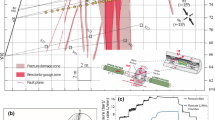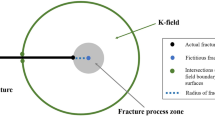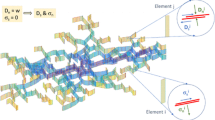Abstract
It is proposed that the growth of fractures is the basic process for generating and maintaining permeability in solid rock (bedrock). Many extension fractures grow as hydrofractures, whereas many shear (and extension) fractures grow through the formation of transverse fractures that connect the adjacent tips of existing fractures. In a boundary-element analysis, the hydrofractures are modeled as being driven open by a fluid overpressure that varies linearly from 10 MPa at the fracture centre to 0 MPa at the fracture tip. The host rock has a uniform Young's modulus of 10 GPa, a Poisson's ratio of 0.25, and is dissected by vertical joints and horizontal contacts, each of which is modeled as an internal spring of stiffness 6 MPa m−1. The number of joints and contacts, and their location with respect to the hydrofracture tip are varied in different model runs. The results of the analyses indicate that the tensile stresses generated by overpressured hydrofractures open up joints and contacts out to considerable distances from the fracture tip, so that they tend to link up to form a hydraulic pathway. Using the same Young's modulus, Poisson's ratio, and internal spring constant for joints as in the hydrofracture models, boundary-element models were made to study the interaction stresses that cause neighbouring joints to become interconnected through the growth of linking transverse fractures that, ultimately, may evolve into shear fractures. The models were subjected to tensile stress of 6 MPa acting normal to the joint planes as the only loading. The offset (horizontal distance) and underlap (vertical distance) between the adjacent tips of the joints were varied between model runs. The results show a concentration of tensile and shear stresses in the regions between the neighbouring tips of the joints, but these regions become smaller when the underlap of the joints decreases and changes to overlap. These stress-concentration regions favour the development of transverse (mostly shear) fractures that link up the nearby tips of the joints, so as to form a segmented shear or extension fracture. Analytical results on aperture variation of a hydrofracture in a homogeneous, isotropic rock are compared with boundary-element results for a hydrofracture dissecting layered rocks. The aperture is larger where the hydrofracture dissects soft (low Young's modulus) layers than where it dissects stiff layers. Aperture variation may encourage subsequent groundwater-flow channeling along a pathway generated by a hydrofracture in layered rocks.
Résumé
Nous proposons que le développement des fractures est le processus de base qui génère et maintient la perméabilité des roches indurées de socle. De nombreuses fractures en extension se forment en tant qu'hydrofractures, tandis que de nombreuses fractures de cisaillement (et en extension) se développent par la formation de fractures transverses qui mettent en connexion les parois adjacentes de fractures existantes. Dans une analyse des éléments aux limites, les hydrofractures sont modélisées comme si elles étaient maintenues ouvertes par une surpression de fluide qui varie linéairement de 10 MPa dans la fracture à 0 MPa sur sa paroi. La roche magasin possède un module de Young uniforme de 10 GPa, un rapport de Poisson de 0.25, et est recoupée par des fractures verticales et des joints horizontaux, chacun étant modélisé comme une source interne avec une rigidité de 6 MPa m−1. Le nombre de fractures et de joints et leur localisation par rapport aux parois de l'hydrofracture varient dans les différents traitements de modélisation. Les résultats des analyses indiquent que les contraintes de tension générées par les hydrofractures en surpression ouvrent les fractures et les joints sur des distances considérables à partir des parois de la fracture, de telle sorte qu'elles tendent à se connecter pour former un cheminement hydraulique. En utilisant le même module de Young, le même rapport de Poisson et la même constante de source interne pour les fractures que dans les modèles d'hydrofracture, des modèles d'éléments aux limites ont été élaborés pour étudier les contraintes d'interaction qui provoquent l'interconnexion de fractures voisines grâce à l'extension de fractures transverses qui, finalement, peuvent évoluer en fractures de cisaillement. Les modèles ont été soumis à un effort de traction de 6 MPa appliqué normalement aux plans de fracture comme unique charge. Le déplacement (en distance horizontale) et l'écartement (en distance verticale) entre les parois des fractures ont varié selon les différents traitements. Les résultats montrent une concentration de contraintes de tension et de cisaillement dans les secteurs entre les parois des fractures, mais ces secteurs se réduisent lorsque l'écartement des fractures diminue et devient un recouvrement. Ces zones de concentration des contraintes favorisent le développement de fractures transverses (principalement de cisaillement) qui mettent en relation les parois voisines des fractures de manière à former une fracture segmentée de cisaillement ou d'extension. Les résultats analytiques sur la variation de l'ouverture d'une hydrofracture dans une roche homogène et isotrope sont comparés aux résultats des éléments aux limites pour une hydrofracture recoupant des roches litées. L'ouverture est plus large lorsque l'hydrofracture recoupe des couches tendres (module de Young faible) que lorsqu'elle recoupe des couches rigides. La variation de l'ouverture peut favoriser la chenalisation pour un écoulement souterrain subséquent le long d'un cheminement généré par une hydrofracture dans des roches litées.
Resumen
Se propone que el crecimiento de fracturas es el proceso básico de generación y mantenimiento de la permeabilidad en rocas sólidas (roca madre). Muchas fracturas extensivas crecen por fracturación hidráulica, mientras que muchas fracturas de cizalla (y extensivas) lo hacen mediante la formación de fracturas transversales que conectan los extremos adyacentes de fracturas existentes. Por medio de un análisis de elementos de contorno, se ha modelado el crecimiento de las fracturas hidráulicas por un exceso de presión, la cual varía linealmente entre 10 Mpa en el centro de la fractura y 0 Mpa en el extremo. La roca madre tiene un módulo de Young uniforme de 10 Gpa, un coeficiente de Poisson de 0.25, y está diseccionada por diaclasas verticales y contactos horizontales que son modelados, cada uno de ellos, como fuente interna de rigidez igual a 6 MPa m−1. El número de diaclasas y de contactos, así como su situación respecto al extremo de las fracturas hidráulicas, han sido modificados en diferentes pasadas del modelo. Los resultados de los análisis indican que las tensiones generadas por fracturas hidráulicas sobrepresionadas abren las diaclasas y contactos a distancias considerables del extremo de la fractura, de manera que tienden a unirse y a formar caminos o vías de flujo. Utilizando para las diaclasas el mismo módulo de Young, coeficiente de Poisson y manantial interno constante que se empleó en los modelos de fracturas hidráulicas, se ha elaborado modelos de elementos de contorno para estudiar las tensiones de interacción que causan la interconexión de diaclasas vecinas por medio del crecimiento de fracturas transversales de enlace, y que pueden llegar a convertirse en fracturas de cizalla. Los modelos fueron sometidos a tensiones de 6 Mpa normales a los planos de diaclasas como única carga. Se ha modificado el acomodo o distancia horizontal ("offset") y la distancia vertical ("underlap") entre extremos adyacentes de las diaclasas en las diversas pasadas del modelo. Los resultados muestran una concentración de tensiones y cizallas en las regiones situadas entre extremos vecinos de las diaclasas, pero estas regiones son menores conforme la distancia vertical de las diaclasas decrece y cambia a solapamiento de techo ("overlap"). Estas regiones de concentración de esfuerzos favorecen el desarrollo de fracturas transversales (mayoritariamente de cizalla) que enlazan los extremos vecinos de las diaclasas para formar una fractura segmentada de cizalla o extensiva. Se compara los resultados analíticos de la variación de la apertura de una fractura hidráulica en una roca homogénea e isótropa con los resultados del modelo de elementos de contorno en fracturas hidráulicas que diseccionan rocas estratificadas. La apertura es mayor si la fractura hidráulica disecciona capas deleznables (módulo de Young pequeño) que cuando lo hace en capas rígidas. La variación de la apertura puede favorecer el acanalamiento del flujo de aguas subterráneas a lo largo de caminos generados por una fractura hidráulica en rocas estratificadas.






















Similar content being viewed by others
References
Acocella V, Gudmundsson A, Funiciello R (2000) Interaction and linkage of extension fractures and normal faults: examples from the rift zone of Iceland. J Struct Geol 22:1233–1246
Afrouz AA (1992) Practical handbook of rock mass classification systems and modes of ground failure. CRC Press, London
Amadei B, Stephansson O (1997) Rock stress and its measurement. Chapman & Hall, London
Anderson EM (1951) Dynamics of faulting and dyke formation, 2nd edn. Olivier and Boyd, Edinburgh
Atkins AG, Mai YW (1985) Elastic and plastic fracture. Horwood, Chichester, England
BEASY (1991) The boundary element analysis system user guide. Computational Mechanics, Boston, Massachussetts, USA
Bell FG (2000) Engineering properties of soils and rocks, 4th edn. Blackwell, Oxford
Bergerat F, Angelier J (2001) Mechanisms of the faults of 17 and 21 June earthquakes in the South Iceland Seismic Zone from the surface traces of the Arnes and Hestfjall faults. C R Acad Sci Paris 333:35–44
Bons PD (2001) The formation of large quartz veins by rapid ascent of fluids in mobile hydrofractures. Tectonophysics 226:1–17
Bruhn RL, Parry WT, Yonkee WA, Tompson T (1994) Fracturing and hydrothermal alteration in normal fault zones. Pure Appl Geophys 142:609–644
Caine JS, Evans JP, Forster CB (1996) Fault zone architecture and permeability structure. Geology 24:1025–1028
Cartwright JA, Trudgill BD, Mansfield CS (1995) Fault growth by segment linkage. An explanation for scatter in maximum displacement and trace length data from the Canyonlands Grabens of SE Utah. J Struct Geol 17:1319–1326
Chilingar GV, Robertson JO, Rieke HH (2002) Origin of abnormal formation pressures. In:Chilingar GV, Serebryakov VA, Robertson JO (eds) Origin and prediction of abnormal formation pressures. Elsevier, Amsterdam, pp 21–67
Cook J, Gordon JE (1964) A mechanism for the control of crack growth in all-brittle systems. Proc R Soc Lond A282:508–520
Cox SJD, Scholz CH (1988) On the formation and growth of faults: an experimental study. J Struct Geol 10:413–430
Crider JG, Pollard DD (1998) Fault linkage: three-dimensional mechanical interaction between echelon normal faults. J Geophys Res 103:24373–24391
Evans JP, Forster CB, Goddard JV (1997) Permeability of fault-related rocks and implications for hydraulic structure of fault zones. J Struct Geol 19:1393–1404
Faybishenko B, Witherspoon PA, Benson SM (eds) (2000) Dynamics of fluids in fractured rocks. American Geophysical Union, Washington, DC
Gentier S, Hopkins D, Riss J (2000) Role of fracture geometry in the evolution of flow paths under stress. In: Faybishenko B, Witherspoon PA, Benson SM (eds) Dynamics of fluids in fractured rock. American Geophysical Union, Washington, DC, pp 169–184
Goodman RE (1989) Introduction to rock mechanics, 2nd edn. Wiley, New York
Gudmundsson A (1987a) Tectonics of the Thingvellir fissure swarm, SW Iceland. J Struct Geol 9:61–69
Gudmundsson A (1987b) Geometry, formation and development of tectonic fractures on the Reykjanes Peninsula, southwest Iceland. Tectonophysics 139:295–308
Gudmundsson A (1992) Formation and growth of normal faults at the divergent plate boundary in Iceland. Terra Nova 4:464–471
Gudmundsson A (1995) Geometry and growth of dykes. In: Baer G, Heimann A (eds) Physics and chemistry of dykes. Balkema, Rotterdam, The Netherlands, pp 23–34
Gudmundsson A (1999) Postglacial crustal doming, stresses and fracture formation with application to Norway. Tectonophysics 307:407–419
Gudmundsson A (2000a) Active fault zones and groundwater flow. Geophys Res Lett 27:2993–2996
Gudmundsson A (2000b) Fracture dimensions, displacements and fluid transport. J Struct Geol 22:1221–1231
Gudmundsson A, Brenner SL (2001) How hydrofractures become arrested. Terra Nova 13:456–462
Gudmundsson A, Brynjolfsson S, Jonsson MT (1993) Structural analysis of a transform fault-rift zone junction in North Iceland. Tectonophysics 220:205–221
Gudmundsson A, Fjeldskaar I, Brenner SL (2002) Propagation pathways and fluid transport of hydrofractures in jointed and layered rocks in geothermal fields. J Volcanol Geotherm Res 116:257–278
Haneberg WC, Mozley PS, Moore JC, Goodwin LB (eds) (1999) Faults and subsurface fluid flow in the shallow crust. American Geophysical Union, Washington, DC
Hubbert MK, Willis DG (1957) Mechanics of hydraulic fracturing. Am Inst Mining Eng Petrol Trans 210:153–188
Hudson JA, Harrison JP (1997) Engineering rock mechanics: an introduction to the principles. Pergamon, Oxford
Johnson AM (1970) Physical processes in geology. Freeman, Cooper & Company, San Francisco, California, USA
Jumikis AR (1979) Rock mechanics. Trans Tech Publications, Clausthal, Germany
Lamb H (1932) Hydrodynamics, 6th edn. Cambridge University Press, Cambridge
Mansfield C, Cartwright J (2001) Fault growth by linkage: observations and implications from analogue models. J Struct Geol 23:745–763
Maugis D (2000) Contact, adhesion and rupture of elastic solids. Springer, Berlin Heidelberg New York
Muirwood R, King GCP (1993) Hydrologic signatures of earthquake strain. J Geophys Res 98:22035–22068
Paterson MS (1978) Experimental rock deformation. The Brittle Field. Springer, Berlin Heidelberg New York
Peacock DCP, Sanderson DJ (1999) Deformation history and basin-controlling faults in the Mesozoic sedimentary rocks of the Somerset coast. Proc Geol Assoc 110:41–52
Pollard DD, Segall P (1987) Theoretical displacements and stresses near fractures in rock: with application to faults, joints, veins, dikes and solution surfaces. In: Atkinson B (ed) Fracture mechanics of rock. Academic Press, London, pp 277–349
Priest SD (1993) Discontinuity analysis for rock engineering. Chapman & Hall, London
Roeloffs EA (1988) Hydraulic precursors to earthquakes: a review. Pure Appl Geophys 126:177–209
Rojstaczer S, Wolf S, Michel R (1995) Permeability enhancement in the shallow crust as a cause of earthquake-induced hydrological changes. Nature 373:237–239
Secor DT (1965) The role of fluid pressure in jointing. Am J Sci 263:633–646
Selley RC (1998) Elements of petroleum geology. Academic Press, New York
Seront B, Wong TF, Caine JS, Forster CB, Bruhn RL (1998) Laboratory characterisation of hydromechanical properties of a seismogenic normal fault system. J Struct Geol 20:865–881
Singhal BBS, Gupta RP (1999) Applied hydrogeology of fractured rocks. Kluwer, London
Sneddon IN (1973) Integral transform methods. In: Sih GC (ed) Mechanics of fracture. I. Methods of analysis and solutions of crack problems. Nordhoff, Leyden, pp 315–367
Sneddon IN, Lowengrub M (1969) Crack problems in the classical theory of elasticity. Wiley, New York
Spence DA, Sharp PW, Turcotte DL (1987) Buoyancy-driven crack propagation: a mechanism for magma migration. J Fluid Mech 174:135–153
Tada H, Paris PC, Irwin GR (2000) The Stress analysis of cracks handbook, 3rd edn. Del Research Corporation, Hellertown, Pennsylvania, USA
Timoshenko SP, Goodier JN (1970) Theory of elasticity, 3rd edn. McGraw-Hill, London
Twiss RJ, Moores EM (1992) Structural geology. WH Freeman, New York
van der Pluijm BA, Marshak S (1997) Earth structure. McGraw-Hill, New York
White FM (1979) Fluid mechanics. McGraw-Hill, New York
Acknowledgements
We thank the Hydrogeology Journal referees for helpful comments. This work was supported by a grant from the European Commission (contract EVR1-CT-1999-40002), several grants from the Norway Research Council, and a PhD grant from Statoil (to Agust Gudmundsson) for Sonja L. Brenner.
Author information
Authors and Affiliations
Corresponding author
Rights and permissions
About this article
Cite this article
Gudmundsson, A., Gjesdal, O., Brenner, S.L. et al. Effects of linking up of discontinuities on fracture growth and groundwater transport. Hydrogeology Journal 11, 84–99 (2003). https://doi.org/10.1007/s10040-002-0238-0
Received:
Accepted:
Published:
Issue Date:
DOI: https://doi.org/10.1007/s10040-002-0238-0




